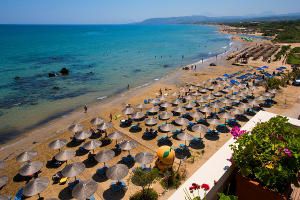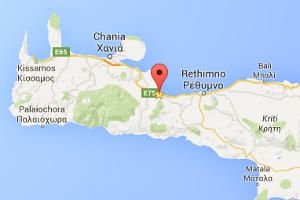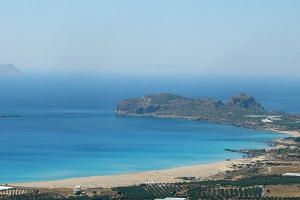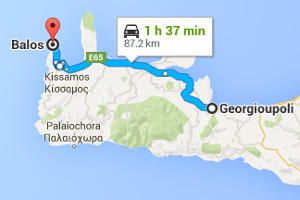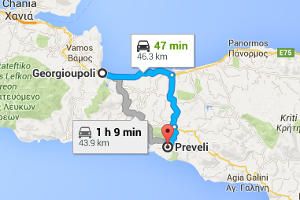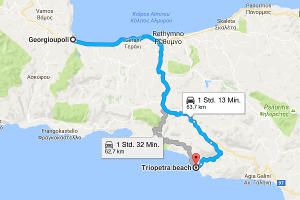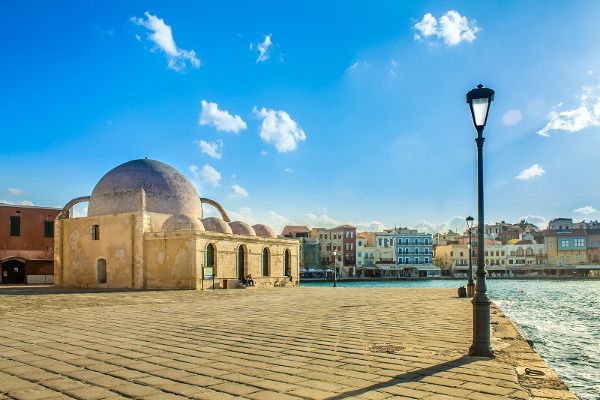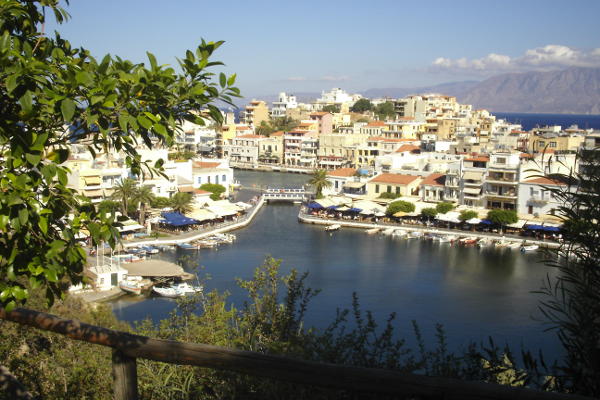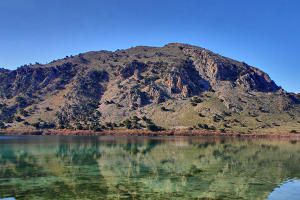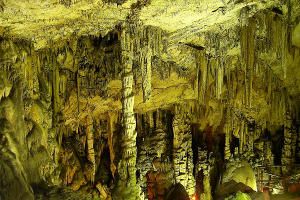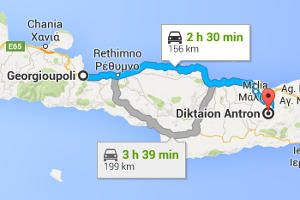- Corissia Travel Guide ™
Discover your own amazing Crete - Things to do - Attractions - Excursions - Activities
Corissia Travel Guide ™
Discover your own amazing Crete
A free travel guide to Crete with valuable insider tips
Welcome to Crete
The island of Crete is a treasure trove for anyone who wants to immerse themselves in the beginnings of European culture and retrace a history that goes back for millennia. At the same time, it is a paradise for those sun worshippers who want to relax and enjoy the sweet life on the beaches, those who want to pamper themselves with culinary delights and to de-stress at wild parties.
That’s because on Crete you will find an impressive holiday setting with long, sandy beaches and idyllic coves; with ancient monuments and medieval castles; with a vibrant nightlife and glorious hiking trails through high mountains and deep ravines.
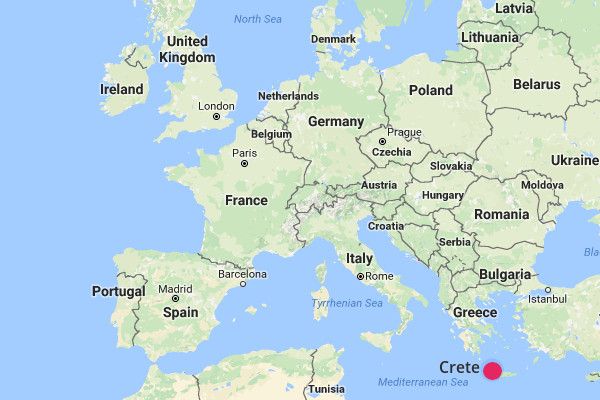
Crete: a holiday destination for those
who love bathing, nature, hiking, history, and culture
Today, Crete
is one of the most popular tourist destinations in the Mediterranean - cosmopolitan yet
mysterious.
"I had the immediate impression that the atmosphere that enveloped me
was something I had never experienced anywhere else.
It seemed clearer, denser here,
and everything was bathed in a very peculiar light, made of a fabric with a white
background, speckled mauve, green, silver and a little blue.
Every colour
corresponded to a scent that I noticed immediately, because all together they create the
characteristic fragrance of Crete, which encounters you from the very first moment."
The world-renowned Greek composer Mikis Theodoràkis recollects his first visit to Crete, the island of his ancestors.
With approximately 600,000 inhabitants, Crete is the largest Greek island and the most southerly (with the exception of the small island of Gavdos). From east to west, Crete is about 260 km wide, whilst the distance from north to south varies between 15 and 65 km. The island has an area of approximately 8,336 square kilometres.
With its long, flat, sandy beaches, the north coast is the main tourist attraction on the island. All the major cities are also on the North Coast: Chania, Rethymno, Heraklion and Agios Nikolaos. In the south you will find beautiful coastal cliffs and countless idyllic bays.
The mountainous interior, however, is the least known region of the island: a long mountain chain (up to 2456 metres high), which extends over the entire island. This is just the place to look for small, traditional villages and meet the natives of Crete.
Interesting places in Crete at a glance
West
District of Chania
North
City of Chania
City, old town,
harbor, airport, culture, nightlife, shopping
Georgioupolis
Village, sandy beach, resort, hotels, nature, mountain lake,
excursions
Falassarna
Village, sandy beach, archaeological site
Kissamos
Small town, harbor,
boat trips
Kolymbari - Spilia - Tavronitis - Maleme
Village, beach,
resort, hotels
Gerani - Platanias - Agia Marina
Sandy beach, resort,
hotels
Kalathas - Stavros
Village, sandy beach, monastery
Marathi - Loutraki
Village, sandy beach, harbor
Kalyves
Village, sandy beach
Almirida
Village, sandy beach
South
Elafonissi
Sandy beach,
monastery
Paleochora
Village, sandy
beach, resort, hotels, boat trips
Sougia
Village, beach,
gorge
Agia Roumeli- Samaria Gorge
Village, beach, gorge
Loutro
Village, sandy
beach, boat trips
Chora Sfakion
Village, sandy
beach, boat trips
Frangokastello
Castle,
sandy beach
District of Rethymno
North
City of Rethymno
City, old
town, harbor, culture, nightlife, shopping
Argyroupolis
Mountain
village, nature, water springs, ancient city
Eleftherna
Mountain village, ancient city, archaeological
site, museum
Adelianos Kampos - Sfakaki - Skaleta
Village, beach,
resort, hotels
Panormos
Village, beach, resort, hotels
Bali
Village, beach, resort, hotels
Melidoni
Mountain village, nature, Stalactite cave
Anogia
Mountain village, nature, Culture, Music
South
Spili
Mountain village, nature
Plakias
Village, sandy beach, resort, hotels
Preveli
Sandy beach,
monastery
Triopetra - Agios Palvos
Sandy beach
Agia Galini
Village, beach
District of Heraklion
North
City of Heraklion
City, old
town, harbor, airport, culture, nightlife, shopping
Fodele
Village, sandy beach
Agia Pelagia
Village, beach, resort, hotels
Chersonisos
Village, beach, resort, hotels
Anissaras
Beach, resort, hotels
Stalida
Beach, resort, hotels
Malia
Beach, resort, hotels
South
Zaros
Small town
Mires
Small town
Timpaki
Small town
Matala
Village, sandy
beach
Lendas
Village, beach
East
District of Lassithi
North
Elounda
Village, beach,
resort, hotels
Agios Nikolaos
Small
town, harbor
Pachia Ammos
Village,
beach
Mochlos
Village, beach
Sitia
Small town, old town,
harbor
South
Xerokampros
Village,
beach
Makry Gialos
Village,
sandy beach, boat trips
Ierapetra
Small town,
harbor
Ancient palaces and modern hotel complexes; chic seaside resorts and faraway mountain villages, lively beaches and rugged mountain landscapes, traditional delicacies and health spas - with this distinctive blend you are guaranteed to discover heavenly Crete for yourself.
Beaches & Seaside Resorts on Crete
Crystal-clear seas and smooth, golden sandy
beaches
Long, sandy beaches, rocky reefs & small bays
In Crete, the sun shines more than 300 days a year. So it’s no wonder that the island attracts so many sun worshippers and beach devotees, as there is a considerable choice of beaches.
Below, you will find some examples of Crete’s most beautiful beaches:
The sandy beach of Georgioupolis
Crete’s longest sandy beach is situated on the island’s north coast between the cities of Chania and Rethymno. This beautiful, sandy beach stretches over 10 km eastward from the fishing village of Georgioupolis, where the Corissia Hotels are situated. The beach descends gradually into the water and is considered to be very clean, making it perfect for a seaside holiday, especially with children.
The sandy beach of Falassarna
Crystal-clear waters and white sand make the sandy beach of Falassarna a popular daytrip destination for holidaymakers and locals alike. This broad beach is situated in the north-west of Crete and easily reached by car.
The sandy beach of Balos - Gramvousa
Balos, the blue lagoon, is situated in the north-west of Crete. It's a breathtaking bay with a heavenly sandy beach on the western side of Gramvousa Peninsula. You can reach Balos either by car (partly dirt track) and then down a flight of stairs, or by boat from Kastelli Kissamos.
The sandy beach of Elafonissi
On the south-west tip of Crete, you will find the beautiful sandy beach of Elafonissi and the eponymous small island, which you can walk to across a flat sand bank. An incredibly beautiful daytrip destination for total relaxation.
The palm-lined beach of Preveli
In a small bay by the Libyan Sea on Crete’s south-west coast lies the unique palm-lined beach of Preveli. A mountain stream lies behind the sandy beach, enticing you into a ravine lined with Cretan date palms. A unique ‘tropical landscape’ on Crete.
The sandy beach of Triopetra
To the south of the island you will also find the beautiful sandy beaches of Triopetra, which are relatively unknown to tourists. A small peninsula with the characteristic triple rock formation (‘Triopetra’) extends between two tranquil and generally unfrequented beaches. A great spot for bathers and couples looking for peace and quiet.
The sandy beach of Agios Pavlos
Virtually endless coarse sand awaits you 11 km west from Agia Galini as the crow flies. On the section where the tavernas are located, the beach is only about 200 m long, but west of this mini-beach, steps lead you up to a bare plateau. Once you’ve arrived up on Melissa Cape, you will immediately clap eyes on what is perhaps the most beautiful cliffside in all of Crete. It is known as ‘Diplono Petris’. It is only a few metres high, but rocky folds run through it with regular, wave-like patterns in a whole variety of colours. On the other side of the plateau, you can descend to a coarse, sandy beach with hardly a soul in sight that stretches for miles, almost up to Triopetra.
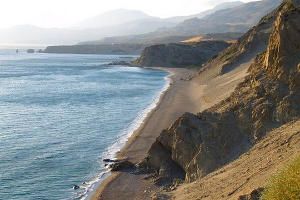
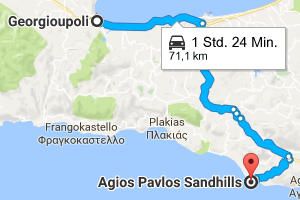
Open the sandy beach in Agios Pavlos in Google Maps
In order to reach Agios Pavlos, take the street from the north coast to Agia Galini and then turn left after Kria Vrisi down towards the Libyan Sea.
The sandy beach & Red Beach of Matala Matala
The sandy beach and the ‘Red Beach’ of Matala lie on the south coast of Crete, on a beautiful bay by the Libyan Sea. Matala may only be a tiny village with less than 100 inhabitants, but it is world famous. Its good reputation is especially thanks to the hippies who lived here from the end of the 60s into the 70s.
The cities of Crete
Shop -
Stroll - Savour
All the cities on our island are by the sea. Those living there will always find beaches nearby, but the mountains are never far away either, highly visible as they tower up from the island’s interior into skies that are almost perpetually blue. In winter, the peaks are often snow-capped from November until late March. Many city-dwellers then drive up into the mountains, build snowmen on the bonnet of their cars and then try to bring them back down into the city in one piece.
The island’s capital is Iraklion (Heraklion), with approximately 150,000 inhabitants. In 2nd and 3rd place are Chania and Rethymno. After these come Agios Nikolaos, Kissamos and Sitia. They all line the coast of the Sea of Crete. To the south of the island, by the Libyan sea, Ierapetra is the only city.
The historic city centres of Iraklio and Chania are still almost entirely surrounded by their medieval walls on the seaward side. A mighty fortress towers over the historic centre of Rethymno, harking back to the Middle Ages. The historic centres of Chania and Rethymno are real jewels of Venetian architecture with some Ottoman edifices as well, and still exude plenty of historical flair. Here, you can imagine yourself back in times gone by. This is less so in the historic centre of Iraklio. Following the devastating destruction of the Second World War, the historic centre was reconstructed swiftly and indiscriminately. Nevertheless, the juxtaposition of old monuments with modern city life has a charm of its own. Since 1971, all three cities have been the site of the various faculties of the University of Crete. Their lecturers and students revitalise the nightlife in particular, and keep Crete young.
All three large cities are within easy reach for a daytrip from Georgioupolis. Your best mode of transport are the public buses, which cover the route from Chania via Georgioupolis and Rethymno to Iraklio at least every hour from early morning until late at night. This lets you do without the long search for a parking spot, parking fees, or even a parking ticket in the cities, and allows you to sample raki or wine at your leisure. Alternative options include tour coaches or taxis.
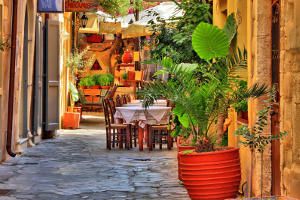

On the next few pages, we will introduce you to Crete’s larger cities, with suggestions for each one as to how you can spend a pleasant, relaxing and interesting time there. Get more, fascinating details about the individual sights and museums via the corresponding links.
Chania
Chania, only 40 km from Georgioupolis, outshines its rivals with its romantic, Venetian harbour. This unique backdrop features the old lighthouse, Firkàs Fortress, the mosque with its great, white dome and pastel-coloured houses from the 16th, 17th and 18th centuries. There is a wide selection of restaurants, cafés and bars on the harbour promenade. Every evening, the whole city gathers here to mingle.
A wander through the winding alleyways around the harbour takes you past small churches, shops, tavernas and museums. Be sure not to miss out on a visit to the old market hall, with fresh fruit and vegetables, dozens of kinds of cheese and a wide selection of herbs and spices.
Most beautiful of all is the view of Chania from the water. To enjoy this view, you have two options: either you walk out along the harbour pier, or you take a short boat trip out to sea. Then you too are sure to be impressed by the beauty of the old city, set against the backdrop of orange groves and high mountains.
Rethymno
Rethymno lies 20 km east of Georgioupolis. The historic centre of Rethymno impresses with its well preserved Venetian patrician houses dating back to the 16th and 17th centuries, and the Turkish buildings of the 18th and 19th centuries. There is a wide selection of shops and tavernas in the narrow alleyways, which are mostly pedestrian zones.
The striking 16th-century Fortézza fortress towers high above Rethymno, dominating the city skyscape. Concerts and theatrical performances are held here in summer. The small Venetian harbour is a stone’s throw away. You can enjoy the island’s varied, delicious fish dishes in several dozen tavernas. Somewhat further east, the modern seaside promenade beckons with countless restaurants, cafés and bars. The sandy beach stretches on for miles, beckoning you to swim and laze around.
If you visit Rethymno in July, a very special experience awaits: you can then celebrate the extensive wine festival with the locals. It’s a particularly exuberant affair. The wine flows freely, and the infectious Cretan music begs you to dance.
Heraklion
A visit to the capital of Crete, Heraklion, is also an absolute must. Only about an hour and a half’s drive from our little fishing village, this pulsing metropolis is well worth a daytrip.
Within its fortified walls, you still find glorious Renaissance and Baroque monuments, such as St Mark’s Basilica, the Loggia and Morosini fountain at the heart of the historic centre. The harbour is overshadowed by the defiant Koules Castle dating back to the 16th century.
A visit to Aghios Titos Church is particularly interesting. The body of St Titus, a disciple of the Apostle Paul, lies buried here. A stroll along the fortified walls of Heraklion takes you to the grave of the great writer, Nikos Kazantzàkis. Excommunicated by the church and refused Christian burial, his body was interred here. One of his maxims is etched into the gravestone, summarising author Alexis Sorbas’ attitude towards life: 'I hope for nothing. I fear nothing. I am free.'
IThe heartbeat of Heraklion can be felt around Phokà Sqaure within a radius of a few hundred metres. During the day, hundreds of shops beckon you on an extensive shopping spree. Here you will find everything from Cretan cheese and wine to Japanese fashion designs. In the evening, countless restaurants offer culinary delights to every taste, and you can end the day in one of the atmospheric bars, or with a stroll through the narrow, lively alleyways of the historic centre.
Agios Nikolaos
To the east of Crete lies Agios Nikolaos, a modern, tranquil small town. The focal point of this cosmopolitan seaside resort is its small lake, connected to the sea by a canal. All around the lake, there is a large selection of restaurants, cafés and bars, enlivened by the colourful, but not overwhelming flow of party-goers.
The area between Agios Nikolaos and nearby Elounda is particularly popular among visitors. Spinalonga, the small island before Elounda, also served as a military base under the Ottomans until the beginning of the 20th century, when Crete was liberated from Ottoman rule. Today, you can see the large fortress complex on Spinalonga, as well as two churches, a small graveyard and the houses in which the Venetians and Ottomans once lived. A small exhibition describes the harsh life on this tiny island.

Kissamos
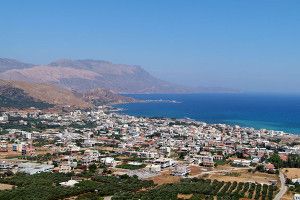
Tourism takes a backseat in the most western town on Crete. Its inhabitants, easily numbering only 4,000, make their livelihood from the many farmers in the surrounding area, who buy and sell here. Nothing is really spruced up, except the short shoreline promenade; plenty is rustic and typical of the Cretan countryside. You will experience this particularly on a workday morning. Otherwise, life here is quiet and sedate.
Sitia
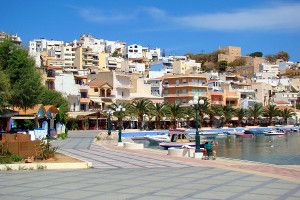
Like its western counterpart, Kissamos, Crete's most eastern town (14,500 inhabitants) is a quiet little rural town with a modest number of tourists. Here too, the backbone of the local economy is comprised of farmers from the wider community who come here to shop. Unlike Kissamos, Sitia makes more of a well-planned impression, rather than uncontrolled growth. This makes the historic centre between the harbour and the small, Venetian/Ottoman castle particularly charming.
Ierapetra

The only city on the southern coast of Crete is surrounded by two seas: the Libyan Sea and a sea of greenhouses. These have brought prosperity to the region's farmers since the 1960s. Their pick-ups dominate the streets in the town centre, which has grown haphazardly over time. The long, car-free shoreline promenade and the small historic centre, where even Emperor Napoleon is said to have spent the night, are truly charming.
Crete: land of wonders and wanders!
special
sights und selected tours
Glorious hiking trails through high mountains and deep ravines, faraway mountain villages, antique monuments and medieval castles.
Crete has been a popular hiking destination for decades. Its high mountains, olive groves and vines, the clifftop paths high above the sea, the quaint, traditional villages and antique ruins create an impressive and particularly diverse backdrop.
The fascination of Crete also lies in the fact that it has retained so much of its traditional rural origins.
Going for a drive through Crete is like taking a long stroll through the best that nature has to offer.
Many roads have been well developed in recent years. What's remained are the many curves, the constant up and down in the hills and high mountains, and the sheep and goats that just love to hang out by the roadside or right on the tarmac. In nearly every village, a small kafenion bids you a warm welcome and numerous tavernas await your visit.

Georgioupolis is an ideal location from which to explore central and western Crete.
Besides widely renowned sights, many small, hidden treasures await you a few hundred metres from the thoroughfares. There you can discover small, medieval churches and chapels, most of which are accessible at all times. Come across ancient remains, arrive at silent monasteries, and drive through olive and orange groves.
Small gorges and caves, often steeped in history, are begging to be explored. There are many charming spots for a small picnic in between times, and the odd beautiful souvenir to be acquired in workshops and artisan studios. Be sure to bring your swimming gear, as a good beach is lying off almost every route on our island.
Georgioupolis is an ideal location from which to explore central and western Crete on day trips by bus or rental car. You can also take many of these tours by motorbike or on a Vespa scooter. Bring the basics, including drinking water and enough sunscreen, in a small daypack; If you want to take a short walk in between times, shoes with a firm grip are also very useful.
The Samaria Gorge
Samaria National Park is the most popular hiking destination on the island. This is the longest and most famous gorge in Europe, lying in the White Mountains in the district of Chania. It's open to hikers from May to October. Good grip and comfortable walking shoes are prerequisites.
The mountain lake of Kournas
Situated in the immediate vicinity, only 4 km from Georgioupolis, Lake Kournas is the only natural freshwater lake in Crete, lying at the north-eastern foot of the White Mountains. It is an important habitat for rare turtles (the diamondback terrapin), green lizards and various species of bird and dragonfly.
Argyroupolis Springs
The idyllic mountain village of Argyroupolis is also located at the north-eastern foot of the White Mountains, just 16 km from Georgioupolis, on the territory of the ancient city of Lappa. Visitors here experience a stunning setting with picturesque waterfalls, romantic tavernas, small chapels and narrow streets.
Tour through the White
Mountains
'Remote villages and secluded valleys'
This scenic tour takes you around two distinctive peaks of the White Mountains, Fourni and Agathes, each approximately 1500 m high. You will enter remote villages on tiny plateaus, where only a handful of people live.
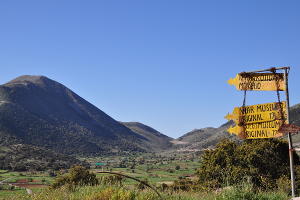
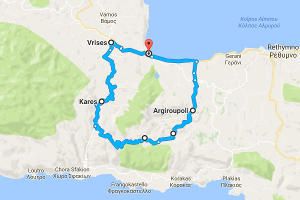
Open the mountain tour in Google Maps
Georgioupolis - Askifou plateau - Kares - Imbros - Asfendou - Kallikratis - Myriokefala - Argyroupolis (approx. 80 km)
Tour through the peninsula of Apokoronas
On this peninsula, which juts out between Georgioupolis and the Bay of Souda on the Aegean, you have time enough for a chat with the locals in the lovely coffee shops, for a short hike in natural surroundings, and for a dip and lunch right by the sea. During all of this, white mountains, sea, the Akrotiri peninsula and the city of Chania can often all be seen from the same viewpoint.

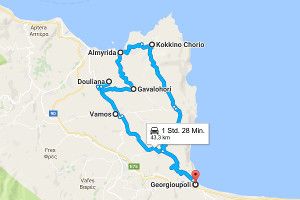
Georgioupolis - Vamos - Douliana - Gavalochori - Almirida - Kokkino Chorio - Ombros Gialos (approx. 50 km)
Excursion to the ancient city of Aptera
A colourful mix right next to Georgioupolis: visit an antique theatre with magnificent views of the White Mountains, set foot in colossal cisterns dating back to the Roman period, explore two ancient churches and walk for about 20 minutes through a narrow, lush green ravine to a cave of historical significance.
Trip across the Akrotiri
Peninsula
'Beaches, Monasteries and a Beautiful Hike'
Many of you will have already been on the Akrotiri Peninsula: Chania airport is situated here. You can explore it at your leisure by rental car or motorbike for a day full of diversity, and still have enough time for a swim and for a simple hike with sea views through the most unspoiled nature of Crete.


Georgioupolis - Souda - Agia Triada Monastery (Tzangarolou) - Gouverneto Monastery - Hike - Stavros Beach - Kalathas Beach - The Venizelos Tombs near Chania (approx. 120 km)
Circular route through the hill country at
the northern foot of the White Mountains
'Plenty of nature and a touch of
history'
This tour is an absolute must for nature lovers.
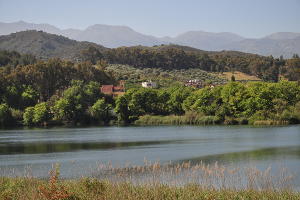
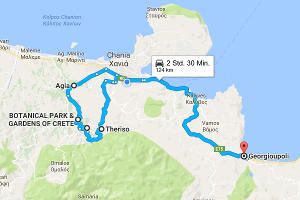
Georgioupolis - Agia - Botanical Park of Crete - Meskla - Therisso (approx. 140 km)
Jeep Tour on the Rodopou
Peninsula
'Rough Tracks in Utter Isolation'
The peninsula between the bays of Chania and Kissamos can still not be accessed by sealed roads. Here, a 4x4 off-road vehicle is the transport of choice, as the dirt roads are sometimes extremely rough. The drive through a landscape devoid of people, but full of sheep and goats, is in itself a great experience. You can visit an abandoned village, indications of an ancient temple, and two pilgrimage churches in complete isolation.


Georgioupolis - Kolimbari - Afrata - Diktynna - Agios Ioannis - Agios Pavlos - Rodopou - Ravdoucha (approx. 180 km)
Day Trip to Falassarna and
Polirrinia
'Antiquity Amid the Most Beautiful Landscapes'
The main destination of this trip are two archaeological sites far from the beaten track in westernmost Crete. You will drive through landscapes that are visited only rarely, you can purchase unique souvenirs direct from artisans, visit the little town of Kissamos and, naturally, bathe at a top beach as well.


Georgioupolis - Kissamos - Falassarna - Lousakies - Polirrinia (approx. 190 km)
The various hiking trails in the less explored south-west of the island are just are impressive: enjoy the fabulous view of the coast between Agia Galini and Paleochora and descend steps carved into the rock down onto the beach. Treat yourself after your hiking trail and soak up the sun on the palm-lined beach of Preveli, one of the most beautiful beaches on Crete.
Excursion to the south of
Rethymno
'Palm-lined Beach and Oak Forest'
Today, a dip at a palm-lined beach, a short hike and a small shopping trip are on the cards. You will wander through old tombs in the oak woods of Armeni and wade through a cold river in a palm grove, experience the curious museum of a priest in a mountain village, visit an abandoned monastery of great historic value and rest by a stream spanned by a very photogenic Ottoman bridge.
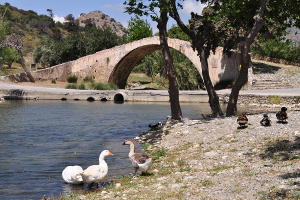
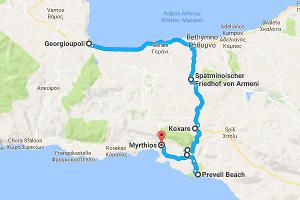
Georgioupolis - Armeni - Koxare - Kourtaliatiko Gorge - Asomatos - Preveli - Myrthios - Kotsifou Gorge (approx. 90 km)
Excursion to the Lassithi
Plateau
''Birth Cave of Zeus'
The Lassithi Plateau in the Dikti mountain range has become world famous due to its countless, canvas-covered windmills. Today, they are almost only to be seen on old postcards. The dripstone cave, in which Zeus, father of the gods, was raised by the goat Amaltheia, is still there. The plain and the drive up also offer great scenic beauty, dotted with interesting monasteries, a whimsical museum and beautiful village squares.
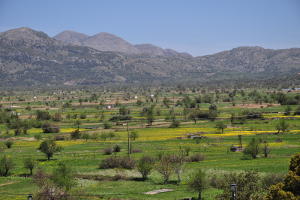
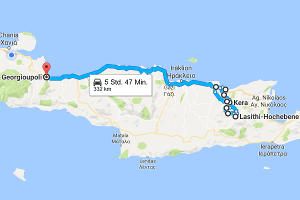
Georgioupolis - Stalida - Mochos - Kardiotissas Monastery - Museum of Mankind - Ambelos Afin - Psychro Cave of Zeus - Avdou - Potamies - Chersonissos (approx. 320 km)
Popular boat trips on Crete
Georgioupolis - Marathi - Almyrida

Chora Sfakion - Loutro - Agia Roumeli
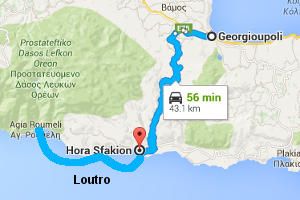
Kissamos (Kasteli) - Gramvousa - Balos

Historic Crete!
An island where
fact and fable are interwoven
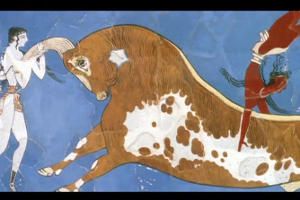

Europe's first advanced civilisation
The Palace of Knossos
At every turn, you will experience how fact and fable are interwoven on Crete. This is particularly the case in the archaeological site of Knossos, situated only a little more than hour away from Georgioupolis.
The extensive, richly decorated palace complex was built during the golden age of the Minoan civilisation in the 2nd century A.D. Europe's first advanced civilisation was named after the legendary King Minos, son of Zeus and Europa. It was lost for millennia.
It was only in 1900 that the English archaeologist, Sir Arthur Evans, discovered the Palace of Knossos. Since then, archaeological digs shed light on the ancient cities of Crete, one by one.
There were several kingdoms in Crete as early as 2000 B.C. We can say with certainty that there were three kingdoms in Knossos, Festos and Màllia. Between 1700 and 1300 B.C., however, Knossos ruled over the entire island. The spectacular palace complex was the symbol of its power. Only a few remains of the old palace have survived the millennia, but you can admire the impressive ruins of the more recent palace dating back to the 15th and 14th century B.C.
Go on a journey of discovery through the magnificent palace: admire the throne room and the frescos of the Prince of the Lilies, stride through the storage rooms with their giant clay vessels, or the Queen's apartments with its dolphin wall paintings and the royal bath tub.
Thanks to reconstructions by archaeologist Sir Arthur Evans, today we have an image of the beauty of this winding palace structure, with more than a thousand rooms, stairs and light shafts. Some of the chambers were luxuriously fitted with bath tubs, toilets and running water.
The whole palace is decorated with frescos of unusual beauty. Incidentally, the originals are on display in the Archaeological Museum of Heraklion.


The divine marriage of Europa
Dhiktéo Andro, the birthplace of Zeus
The road begins close to Chersonissos, leading to the fertile Lassithi Plateau. This is where the Diktaion Antron (Psychro) is situated, the most significant of over 3,400 caves in Crete. Countless archaeological finds confirm that this cave has been used as the sight of a cult for millennia.
According to the myth, Zeus was born in this cave and nourished by nymphs with the milk of Amaltheia. According to another legend, this is also the location where the divine union between Europa and her abductor Zeus took place.
These days, the dripstone cave of Dhiktéo Andro is a popular daytrip destination. The somewhat tiring walk up is richly rewarded: within the caves you will see bizarre rock formations, a small lake, as well as impressive stalagmites and stalactites.
The oldest surviving written legislation in Europe
The ancient city of Gortys
Most interesting of all, however, is a visit to the ancient city of Gortys (Gortina) in the olive grove of Aghii Dhéka. Gortys was founded in the 2nd century B.C., but its glory days only started when Crete was conquered by the Romans, and they named it the island's capital.
So far, only a small section of the ancient city has been uncovered. Among the sights are the Odeon, built in the 1st century A.D., the Acropolis from the 10th century B.C. and the Basilica dedicated to St Titus from the 6th century A.D.
Of particular interest is the law carved into a stone dating back to 450 B.C., which legislates over the rights of free citizens and slaves and abolishes the death penalty. It is the oldest surviving written legislation in Europe.

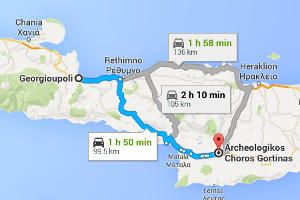
The Palace of Festos
Another daytrip destination in the fertile Messara Plateau in the south of the island. Significant ancient sites are situated here, such as the large Minoan palace complex of Festos, from the 19th century B.C.

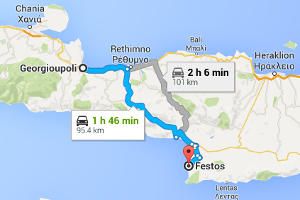
Book a trip to Festos with external tour operators
Roman chamber tombs in Matala
The fishing village of Matala is in the immediate vicinity, with numerous tavernas and small hotels. Above the beach, chamber tombs were carved into the rock face in Roman times, and were a popular meeting place for hippies in the 60s and 70s.
Das antike Falassarna
Ancient Falassarna enjoyed its heyday in the Hellenistic period between about 350 and 67 B.C., meaning it had about 300 prosperous years. In the beginning, it was a significant harbour for the war ships of the Hellenistic rulers, later it developed into an infamous pirates' nest. That's why the Romans destroyed the city in 67 B.C., because they wanted to pacify the Mediterranean. The remains of a settlement have been demonstrated as far back as Minoan times and Classical antiquity.

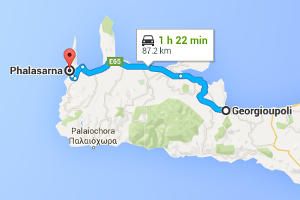
The ancient city of Aptera
For 2000 years, the people of the ancient city of Aptera (emphasis on the first "a") lived on a high rocky plateau, about 1000 m long and approximately 200 m high. People began to settle here as early as 1300 B.C. and in the 4th century B.C. they minted their own coins.
It's only this century that systematic excavations have unearthed, among much more, an ancient theatre of particular beauty. The two enormous cisterns from Roman times are just as impressive.


Few other places in Europe have such a chequered past as Crete.
After the fall of the ancient kingdom, the island was conquered by the Romans. In 827 the Byzantine Province of Crete fell into the hands of the Arabs for a century and a half, before it then was reincorporated into the Byzantine Empire.
During the Fourth Crusade, Venetian troops occupied Crete. The Venetians stayed on the island for nearly 500 years, making an impression that has lasted until this day.
In the 17th century, Crete was conquered by the Turks. Several uprisings against the Ottoman occupation ensued; all were crushed until the liberation of the island in 1898. Union with the Greek state followed in 1913.
Museums of Crete
and other
historic exhibitions
The unique nature of Crete
Crete sends nature lovers' hearts racing all year round. Something blooms and trees bear fruit in every season. The considerable differences in altitude around the island contribute to its great biodiversity. There is also a great climatic difference between the sheltered valleys in the south and the mountain plateaus.
Flora of Crete
Trees &
Plants
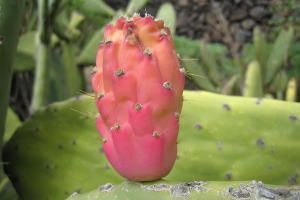
Orange, lemon, grapefruit and arbutus trees bear fruit all through the winter. Crocuses, orchids and anemones are already blooming in February; in April poppies turn some of the archaeological sites and many fields red. At the end of April, gorse, asphodelines and giant fennel start to bloom; in May, oleander blossoms along the streets and the brook beds. In summer, most of the fruit trees bear their fruit; the grape harvest starts mid-August. In autumn, sweet chestnuts ripen, and Greek sowbread blooms by the roadside and in the smallest rock cracks. Then blossoming maritime squill also embellishes many barren hillsides and plateaus close to the sea. Salt cedars also flourish there in autumn - for them, the salty surf is their lifeblood.
One of the 'indigenous' plants on the island is the Cretan date palm, which flourishes in Vai in the eastern outreaches, in the canyon of Preveli on the south coast and near Chrysoskalitissa Monastery in the extreme west. Farmers plant small bananas, which are particularly tasty, and have recently started growing kiwis and avocados as well. The most significant tree on the island, however, is, and always has been, the olive tree. It covers wide areas of Crete and ensures there's work to be done, especially in winter, when many hotels and tavernas on the coast are closed.
The following is an introduction to the most important and most prominent plants and trees. Many of them have also gained significance in mythology and medicine, some are good for unusual recipes - and so enjoy your journey of discovery through nature!
Pomegranate and carob tree
Prickly pear and agave
Giant fennel
Asphodelus and maritime squill
Cistus (rockrose) and Cytinaceae
Ricinus (castor bean) and beetroot
(More to come)
Fauna of Crete
Animals from
smallest to greatest

Crete certainly isn't famed as a safari destination. The average holidaymaker on Crete will only see very few living wild animals. In contrast to the mainland, where approximately 300 brown bears and 800 wolves live in the wild, there is almost no more big game on our island anymore. Only the timid wild goat (capra aegarus creticus), known as agrími or kri-kri in Greek, is still native to some of the uninhabited islands off the coast and in Samaria Gorge. There, however, they are increasingly mingling with the domestic goats, because some of the shepherds from the neighbouring regions drive their goats into the gorge for the purpose of adding genetic diversity, and the odd domesticated billy is sometimes among them. The wild goat population is estimated at approximately 2500 animals. You are sure to spot them in Chania public gardens.
Two very rare, endemic mammals (meaning they are only found on Crete) are the Cretan wildcat (felis silvestris) and the Cretan shrew (croccidura zimmermanni). Other mammals living on the island include rats, hares, rabbits, martens, hedgehogs, badgers, stoats and bats. There are no foxes, which is why the island is also free of rabies.
Geese, and sometimes even bearded vultures, are often spotted in the Cretan mountains, and especially over isolated gorges. There are also golden eagles and the Bonelli's eagle, and ospreys in the Asterousia Mountains on the south coast. The common buzzard is wide-spread. Eleonora's falcons often arrive in summer. Storks are almost never seen on Crete: they avoid the Aegean on their way from Europe to Africa and Southwest Asia, and prefer to migrate closer to land across the Bosphorus.
Rural life on Crete
traditional and close to nature
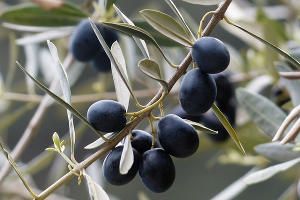
"The beekeeper's colourful hives leave a splash of colour on many hillsides and
harvested fields. Large nets are spread over ancient olive trees right into the spring, and
sometimes even suspended across the streets. As you pass the oil mills, the aroma of the
crushed fruit hangs in the air.
In summer, busy hands harvest the grapes. In some
regions they are hung out to dry on racks, or even spread across the village streets.
Sultanas are the end result.
As of mid-October, columns of smoke rise up all over
the Cretan countryside. That's when the raki distilleries are in operation - at least one in
nearly every village."
More insight into
rural Crete
Crete
a mild, Mediterranean climate
Crete has a temperate, Mediterranean climate. The winter is mild and humid, and the summer is warm with low humidity. The rainy season usually runs from the beginning of November until early March, although snowfall in the coastal region is extremely rare. Nevertheless, the winter can be very cold in the mountainous areas: you can still discern snow on the high mountain peaks right into the late summer months.
What is the best time to travel to Crete?
The
climate table below will help you to find your optimal travel time:
Air
| Temperature in Georgioupolis, Crete |
|
| January | 15° |
| February | 16° |
| March | 17° |
| April | 21° |
| May | 24° |
| June | 28° |
| July | 30° |
| August | 29° |
| September | 27° |
| October | 23° |
| November | 21° |
| December | 17° |
Sea
| Water temperature in Georgioupolis, Crete |
|
| January | 16° |
| February | 16° |
| March | 17° |
| April | 19° |
| May | 20° |
| June | 22° |
| July | 24° |
| August | 25° |
| September | 24° |
| October | 23° |
| November | 20° |
| December | 17° |
Sun
| Hours of sunshine in Georgioupolis, Crete |
|
| January | 5 |
| February | 5 |
| March | 7 |
| April | 8 |
| May | 10 |
| June | 12 |
| July | 13 |
| August | 12 |
| September | 10 |
| October | 8 |
| November | 6 |
| December | 5 |
Travel information
Local time
Greece is in the time zone GMT + 2, which means, for example, that there is two hours’ time difference between the UK and Greece. For instance: 8 pm in Greece is 6 pm in London.
Electricity
The voltage on Crete is 220V. The sockets require a standard European 2-pin plug. You will therefore require an adapter for electronic devices using other plugs.
Entry Requirements
Citizens of EU member states can travel to Greece on a passport or identity card.
Entry requirements for minors
Since
26/06/2012, every child needs their own proof of identity. The inclusion of a child on their
parent's passport is no longer valid. If a child is travelling with only one parent, it is
recommended to bring a self-written (unofficial) declaration of consent signed by the other
person with parental responsibility. All minors travelling alone require an officially
certified declaration of consent signed by the parents or the person with parental
responsibility.
Currency/ Transactions
The official currency in Greece is the euro.
Airports
There are two international airports on Crete: Chania Airport (CHQ) and Heraklion Airport (HER) with heavy air traffic in the summer months. You will find more information about the airports on Crete here (current flight information, incl. arrivals and departures).
Medical care
Crete possesses an extensive network of licensed specialists, state hospitals and private clinics. You will find a modern, private clinic with specialists in Chania. For holidaymakers who regularly need dialysis during their vacation, modern dialysis centres are available in Chania.
It’s recommended to buy travel health insurance before a vacation. In the case of an acute illness or an accident, travel insurance not only enables you to be transported home if required without any difficulty, but also provides optimal medical care locally, for example by highly qualified specialists.
Discover heavenly Crete for yourself
An island full of surprises
A holiday destination for bathing enthusiasts, nature lovers, hikers, and those interested in history and culture. Today, Crete is one of the most popular tourist destinations in the Mediterranean - cosmopolitan and mysterious at the same time.
Popular hotels on the sandy beach
The Corissia Hotels are situated within the tranquil, picturesque village of Georgioupolis right on the sandy beach. An ideal seaside resort both to relax and explore the island, because that is just what holidays on Crete are all about.
Let yourself be pampered
 OUR BEST
OUR BEST 